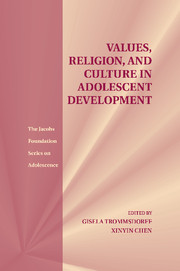Book contents
- Values, Religion, and Culture in Adolescent Development
- Series page
- Values, Religion, and Culture in Adolescent Development
- Copyright page
- Dedication
- Contents
- Contributors
- Preface
- Acknowledgments
- Part One Theoretical Perspectives on Values, Religion, and Adolescent Development in Cultural Context
- Part Two Universal and Culture-specific Functions of Adolescent Values and Religion
- 4 Values and Religion in Adolescent Development
- 5 Religion and Life Satisfaction of Young Persons around the World
- 6 Indonesian Muslim Adolescents and the Ecology of Religion
- 7 Peer Groups as a Crucible of Positive Value Development in a Global World
- 8 Civic Development in Relational Perspective
- Part Three Impact of Values and Religion on Adolescent Adjustment in Times of Social Change
- Part Four Socialization Processes of Values and Religion in Adolescent Development
- Index
6 - Indonesian Muslim Adolescents and the Ecology of Religion
from Part Two - Universal and Culture-specific Functions of Adolescent Values and Religion
Published online by Cambridge University Press: 05 September 2012
- Values, Religion, and Culture in Adolescent Development
- Series page
- Values, Religion, and Culture in Adolescent Development
- Copyright page
- Dedication
- Contents
- Contributors
- Preface
- Acknowledgments
- Part One Theoretical Perspectives on Values, Religion, and Adolescent Development in Cultural Context
- Part Two Universal and Culture-specific Functions of Adolescent Values and Religion
- 4 Values and Religion in Adolescent Development
- 5 Religion and Life Satisfaction of Young Persons around the World
- 6 Indonesian Muslim Adolescents and the Ecology of Religion
- 7 Peer Groups as a Crucible of Positive Value Development in a Global World
- 8 Civic Development in Relational Perspective
- Part Three Impact of Values and Religion on Adolescent Adjustment in Times of Social Change
- Part Four Socialization Processes of Values and Religion in Adolescent Development
- Index
Summary
In this chapter, we provide an overview of our studies that have explored the relations between Indonesian Muslim adolescents’ religiosity and spirituality with their social competence and their relationships with peers and parents. We first reviewed our findings that individual differences in adolescent religiosity and spirituality (SR) was associated with multiple aspects of competence including positive associations with peer acceptance, prosocial behavior, regulation, self-esteem, and academic achievement and negative associations with externalizing behavior, loneliness, and aggression. We then reviewed studies suggesting that religious adolescents tended to develop friendships with others of similar religiosity. These associations predicted that adolescents who were friends with highly religious peers increased their religiosity over time. Finally, we looked at the interconnection between parent–adolescent relations and adolescent SR and adjustment. Parental warmth moderated the relation between parent religiosity and adolescent SR, and SR mediated the relation between parental warmth, parental religiosity, and adolescent prosocial behavior. These results are consistent with our view that in this highly religious community, religion is strongly associated with multiple aspects of adolescents’ lives. Second, we argue that adolescent religiosity must necessarily be understood within a relationship context, an idea that is consistent with an ecological perspective on child and adolescent religiousness.
- Type
- Chapter
- Information
- Values, Religion, and Culture in Adolescent Development , pp. 146 - 163Publisher: Cambridge University PressPrint publication year: 2012
- 3
- Cited by



